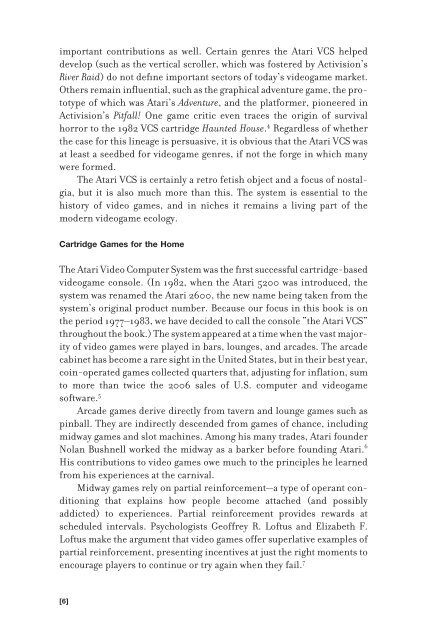Racing the Beam : the Atari Video Computer System - Index of
Racing the Beam : the Atari Video Computer System - Index of
Racing the Beam : the Atari Video Computer System - Index of
Create successful ePaper yourself
Turn your PDF publications into a flip-book with our unique Google optimized e-Paper software.
important contributions as well. Certain genres <strong>the</strong> <strong>Atari</strong> VCS helped<br />
develop (such as <strong>the</strong> vertical scroller, which was fostered by Activision’s<br />
River Raid) do not defi ne important sectors <strong>of</strong> today’s videogame market.<br />
O<strong>the</strong>rs remain infl uential, such as <strong>the</strong> graphical adventure game, <strong>the</strong> prototype<br />
<strong>of</strong> which was <strong>Atari</strong>’s Adventure, and <strong>the</strong> platformer, pioneered in<br />
Activision’s Pitfall! One game critic even traces <strong>the</strong> origin <strong>of</strong> survival<br />
horror to <strong>the</strong> 1982 VCS cartridge Haunted House. 4 Regardless <strong>of</strong> whe<strong>the</strong>r<br />
<strong>the</strong> case for this lineage is persuasive, it is obvious that <strong>the</strong> <strong>Atari</strong> VCS was<br />
at least a seedbed for videogame genres, if not <strong>the</strong> forge in which many<br />
were formed.<br />
The <strong>Atari</strong> VCS is certainly a retro fetish object and a focus <strong>of</strong> nostalgia,<br />
but it is also much more than this. The system is essential to <strong>the</strong><br />
history <strong>of</strong> video games, and in niches it remains a living part <strong>of</strong> <strong>the</strong><br />
modern videogame ecology.<br />
Cartridge Games for <strong>the</strong> Home<br />
The <strong>Atari</strong> <strong>Video</strong> <strong>Computer</strong> <strong>System</strong> was <strong>the</strong> fi rst successful cartridge-based<br />
videogame console. (In 1982, when <strong>the</strong> <strong>Atari</strong> 5200 was introduced, <strong>the</strong><br />
system was renamed <strong>the</strong> <strong>Atari</strong> 2600, <strong>the</strong> new name being taken from <strong>the</strong><br />
system’s original product number. Because our focus in this book is on<br />
<strong>the</strong> period 1977–1983, we have decided to call <strong>the</strong> console “<strong>the</strong> <strong>Atari</strong> VCS”<br />
throughout <strong>the</strong> book.) The system appeared at a time when <strong>the</strong> vast majority<br />
<strong>of</strong> video games were played in bars, lounges, and arcades. The arcade<br />
cabinet has become a rare sight in <strong>the</strong> United States, but in <strong>the</strong>ir best year,<br />
coin-operated games collected quarters that, adjusting for infl ation, sum<br />
to more than twice <strong>the</strong> 2006 sales <strong>of</strong> U.S. computer and videogame<br />
s<strong>of</strong>tware. 5<br />
Arcade games derive directly from tavern and lounge games such as<br />
pinball. They are indirectly descended from games <strong>of</strong> chance, including<br />
midway games and slot machines. Among his many trades, <strong>Atari</strong> founder<br />
Nolan Bushnell worked <strong>the</strong> midway as a barker before founding <strong>Atari</strong>. 6<br />
His contributions to video games owe much to <strong>the</strong> principles he learned<br />
from his experiences at <strong>the</strong> carnival.<br />
Midway games rely on partial reinforcement—a type <strong>of</strong> operant conditioning<br />
that explains how people become attached (and possibly<br />
addicted) to experiences. Partial reinforcement provides rewards at<br />
scheduled intervals. Psychologists Ge<strong>of</strong>frey R. L<strong>of</strong>tus and Elizabeth F.<br />
L<strong>of</strong>tus make <strong>the</strong> argument that video games <strong>of</strong>fer superlative examples <strong>of</strong><br />
partial reinforcement, presenting incentives at just <strong>the</strong> right moments to<br />
encourage players to continue or try again when <strong>the</strong>y fail. 7<br />
[6]


